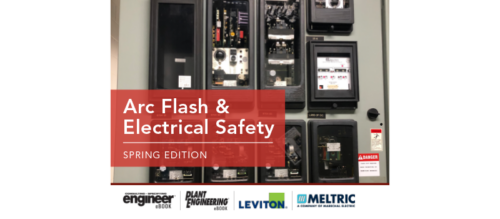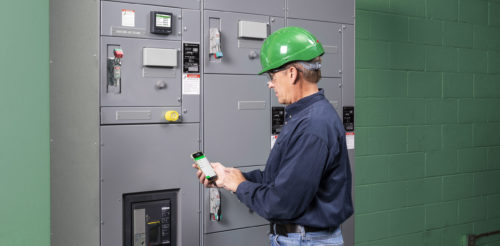Another PPE for arc flash safety: Adopt proven protective exposure
Arc flash hazards have become an increasingly prominent concern as technology enhancements incorporate smaller, higher voltage equipment placed within confined areas. The dangerous result of an electrical system malfunction—essentially, a short circuit between electrified conductors—arc flash explosions can reach up to 35,000º F.
Arc flash hazards have become an increasingly prominent concern as technology enhancements incorporate smaller, higher voltage equipment placed within confined areas. The dangerous result of an electrical system malfunction—essentially, a short circuit between electrified conductors—arc flash explosions can reach up to 35,000
Several measures are available to prevent arc flash injury, including training personnel on arc flash dangers and utilizing personal protective equipment when dealing with live electrical components. Even with these precautions, however, a strong arc flash explosion could still occur—which may result in serious injury or death. The best way to protect personnel and equipment is to mitigate risk as much as possible, and this can be done by integrating another factor into the mix: limiting personnel exposure through specially-designed equipment protection methods.
Currently several agencies have established regulations to help protect personnel in these conditions. Both the Occupational Safety and Health Association and the National Fire Protection Association, through its NFPA 70E standards, require a “flash protection boundary” to protect operators. Essentially, OSHA dictates that electrical work should only take place on de-energized equipment. Only qualified individuals using extensive PPE — including fire-resistant suits and hoods, as well as non-conductive wands — are allowed access to potentially energized equipment capable of generating an arc flash. Companies who are found non-compliant face not only increased risk of operator injury and equipment damage, but also citations and fines from OSHA. In addition, the National Electric Code requires that electrical control panels that might generate arc flash carry a permanent label applied by the panel builder — instantly informing operators of the potential risk level.
These methods significantly assist in protecting personnel, but they also have some shortcomings. The aforementioned label, for example, is important for keeping operators apprised of the level of arc-flash hazard that exists. However, as routine maintenance and repairs are performed, this level may change. Consequently, these outer labels may be an inaccurate representation of the current risk.
When to use PPE
According to NFPA 70E, operators must use PPE when opening an electrical enclosure containing voltage greater than 50 VAC. In other words, all operators working on equipment that might generate an arc flash must wear protective clothing, including fire-retardant suits, gloves, face shield/goggles and other gear as provided by the standards.
This PPE is necessary but often expensive, cumbersome and time-consuming to use. Plus, as previously noted, if a strong arc flash occurs, an operator may suffer significant injuries even with PPE. Most PPE protects users from the heat but not the force of the explosion.
Coinciding with these methods, personnel can be informed about application dangers and protected from arc flash hazards through various equipment protection methods. To further reduce the risks of operator exposure, enclosures that contain equipment that could generate an arc flash may be equipped with auxiliary components, including data interface ports, data pockets and power isolation enclosures. These components provide operators with valuable onsite information and convenient access to the enclosed equipment — without opening the enclosure door.
While no single piece of equipment can completely eliminate arc flash hazards, these components can deliver a cost-effective, safe and easy-to-apply solution for maintaining NFPA 70E compliance during most routine maintenance tasks.
Data interface ports are mounted on an enclosure and provide external plug-ins to the equipment inside. When the panels are properly designed and insulated, they can be wired to enclosed equipment, allowing operators easy access to the programming devices contained. With this arrangement, operators can change settings and monitor performance without opening the enclosure door, limiting their exposure to high-voltage equipment.
Other safety practices
Another way to minimize exposure involves using data pockets that mount on the outside of the enclosure. These are used to house manuals, worksheets and any other documents containing critical information for operators. The data pockets protect records when closed but provide personnel with onsite access to documents when needed.
The third approach interlocks a smaller enclosure, called a power isolation enclosure, with the main enclosure in order to isolate the fused disconnect switch or circuit breaker from the primary control panel. Traditionally, a disconnect switch is located inside the main enclosure, where live power is still being fed upstream to the switch—so the threat of an arc flash incident remains. Instead, a power isolation enclosure is used to house this disconnect switch or circuit breaker, physically removing it from the main enclosure while maintaining a power connection via a terminal block, which is mounted on the shared enclosure walls.
When the disconnect switch is thrown to the “OFF” position, it cuts off all power from entering into the main enclosure. With this arrangement, the disconnect switch or circuit breaker is isolated, and technicians can work inside the main enclosure without the need for PPE (once it is verified that the panel is de-energized).
To mitigate arc flash risk in an environment where high-voltage energized parts are in use, a combination of techniques can effectively inform and protect personnel as well as facilitate convenient maintenance. While warning labels and PPE are key, integrating equipment protection measures such as data interface ports, data pockets and power isolation enclosures can facilitate simple maintenance while further reducing the risk of arc flash injury.
The use of personal protective equipment is one way to mitigate arc flash exposure. Another is to limit exposure to equipment that could cause an arc flash.
Relevant NEC Tables and Articles:
Article 430 contains a number of Tables and points to other Articles that are important to obtain the key data for performing the necessary calculations. Following is a listing of these Tables and Articles. Pay close attention to all Table notes, exceptions, titles, application comments, column headings, and units of measure):
-
Table 430.248: FLC of single-phase AC motors.
-
Table 430.250: FLC of three-phase AC motors.
-
Table 430.52: multipliers used to compute the maximum rating or setting for motor short-circuit and ground-fault protection devices (OCPD’s).
-
Article 240.6: Standard Ampere Ratings of fuses and fixed-trip circuit breakers.
-
Table 430.7(B): locked rotor KVA per HP values for specific induction motor Code Letters.
-
Article 430.32: multipliers used to compute the maximum overload device size.
-
Table 430.37: number and location of required overload units.
-
Do you have experience and expertise with the topics mentioned in this content? You should consider contributing to our CFE Media editorial team and getting the recognition you and your company deserve. Click here to start this process.




